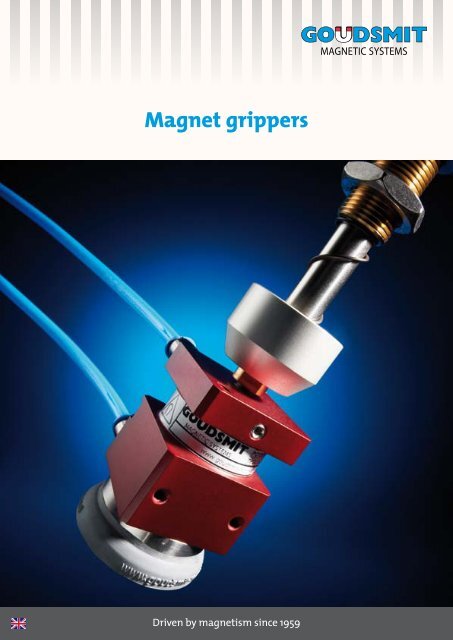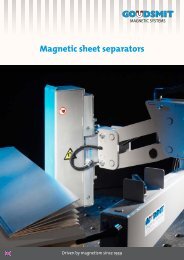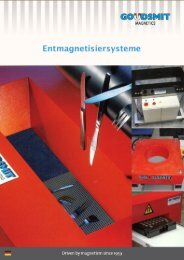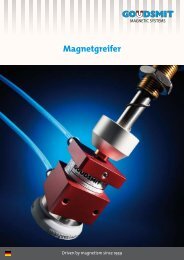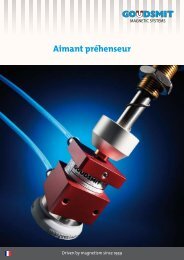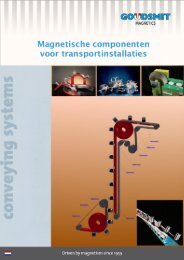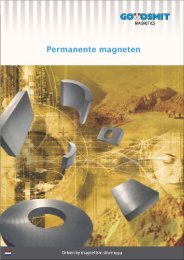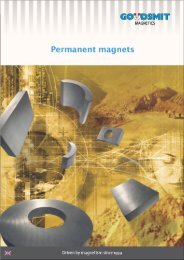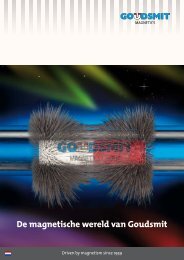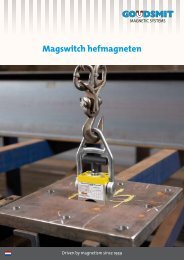Magnet grippers
Magnet grippers - Who-sells-it.com
Magnet grippers - Who-sells-it.com
- No tags were found...
Create successful ePaper yourself
Turn your PDF publications into a flip-book with our unique Google optimized e-Paper software.
<strong>Magnet</strong> <strong>grippers</strong><br />
Driven by magnetism since 1959
Goudsmit <strong>Magnet</strong> <strong>grippers</strong><br />
<strong>Magnet</strong> <strong>grippers</strong> lift both steel plates and perforated products. Also, aluminium and<br />
stainless steel plates and products up to approx. 4 mm are no problem. This makes<br />
these magnetic <strong>grippers</strong> universally applicable in automated processes in laser cutting<br />
machines, robotized press brakes and press-transfer systems in the automotive and<br />
sheet metal industry. Grippers are a proven technology in which the magnets can be<br />
switched on and off using compressed air.<br />
If the magnet is set at high, there is no magnetic field that flows outside and the<br />
gripper is off. If the magnet is set at low, the magnetic field will be moved outside the<br />
housing and the magnet is on. Grippers are widely used for handling sheet metal up to<br />
about 4 mm and smaller steel objects. For heavier steel parts we recommend the<br />
Magswitch heavy lifter.<br />
Operation magnet gripper<br />
MAGNET DOWN à GRAB<br />
MAGNET UP à RELEASE<br />
<strong>Magnet</strong> gripper with flexolink spring plunger<br />
for angle compensation of appr. 5°.<br />
MAGNET<br />
ß Compressed-air<br />
<strong>Magnet</strong> ‘’on’’<br />
<strong>Magnet</strong> ‘’off’’<br />
MAGNET<br />
ß Compressed-air<br />
<strong>Magnet</strong> <strong>grippers</strong> with vacuum<br />
suction pad<br />
<strong>Magnet</strong> <strong>grippers</strong> can lift steel plates, but<br />
also perforated plates. In order to also lift<br />
non-magnetic parts, the gripper optionally<br />
available with a vacuum suction pad.<br />
This doubles the lifting power for steel plates.<br />
This causes the robot arm to be able to<br />
accelerate much faster, which speeds up the<br />
process considerably. Moreover, it is possible<br />
to lift non-magnetic plates without<br />
change-over costs. The vacuum suction pad<br />
prevents the gripper from picking up two thin<br />
plates simultaneously (provided the plates<br />
do not stuck together too much due to oil<br />
residue; then a magnetic plates separator will<br />
be required).<br />
By first switching on the vacuum and then<br />
the magnetic force, only one plate is lifted.<br />
Switching diagram, see page 4.<br />
<strong>Magnet</strong> <strong>grippers</strong> are available from a<br />
diameter of 20 mm (lifting force approx. 3 N)<br />
up to a diameter of 160 mm (lifting force<br />
approx. 800 N). For dimensions we refer you<br />
to our website www.goudsmit.eu<br />
The magnet gripper handles a car door<br />
Type Dimension <strong>Magnet</strong>ic Vacuum Tear Off Advised lifting Advised sheet<br />
(mm) force (N) force (N) kracht (N) force (N) Thickness (mm)<br />
The indicated lifting force is intended for ideal<br />
circumstances. The maximum allowable lifting<br />
force depends on the risk assessment, but must<br />
contain a safety factor of at least 2.<br />
TPGC024078 26 x 63 40 0 40 13 >1<br />
TPGC040078 43 x 63 170 0 170 57 >2<br />
TPGC070078 73 x 71 400 0 400 135 >2<br />
TPGC100078 103 x 71 1300 0 1300 435 >2<br />
TPMV040028 42 x 57 35 70 105 47 >2<br />
TPMV070028 72 x 84 200 260 460 195 >2<br />
TPMV100028 103 x 65 370 540 910 395 >2<br />
page 2 <br />
Goudsmit <strong>Magnet</strong>ics - Driven by magnetism
<strong>Magnet</strong> <strong>grippers</strong> in combination with<br />
vacuum technology<br />
<strong>Magnet</strong> <strong>grippers</strong> are usually applied as<br />
replacement of or in combination with<br />
vacuum technology. The reason for this is that<br />
magnet <strong>grippers</strong> also adhere well on<br />
non-planar and perforated bases. This is not<br />
possible using only a vacuum suction pad.<br />
A magnet gripper requires less precision in<br />
the placement on the object and gives the<br />
user more space in the production process to<br />
perform other actions. A great advantage in<br />
the use of magnets is that no backup system<br />
is required to absorb disturbances.<br />
The magnetic force is still present, even when<br />
the vacuum or the electricity fails.<br />
The magnet gripper can also hold very small<br />
particles. This is not possible with only<br />
vacuum technology, due to the minimum<br />
required diameter of the suction pad.<br />
Another important advantage is the longevity<br />
of magnetic <strong>grippers</strong>. Replacement of the<br />
gripper is not necessary in highly automated<br />
processes. This means lower maintenance<br />
costs.<br />
The MagVacu gripper contains double power (magnet and vacuum) and with this double safety;<br />
especially suitable for handling of non-ferrous parts of perforated in p.e. the automotive industry.<br />
Available accessories and options<br />
Vacuum suction pad at the bottom of the<br />
gripper, for the lifting of non-magnetic parts.<br />
Plunger with flexolink for more variation in the<br />
engagement moment, so that the gripper can<br />
also firmly grasp the object under an angle.<br />
If you want to move the object vertically, we<br />
recommend the gripper with an abrasionresistant<br />
NBR pad. This gives more friction and<br />
prevents that an imprint is left on the object.<br />
Special version for high temperatures >70°C up<br />
to max 180°C.<br />
Goudsmit <strong>Magnet</strong>ics - Driven by magnetism page 3
Standard connection scheme<br />
vacuum valve<br />
Goudsmit vacuum vent valve<br />
TPMV000004<br />
In this situation the vacuum connection is<br />
realized by a Goudsmit vacuum blow-off<br />
valve (TPMV000004).<br />
Connection pressure : 5.5 bar<br />
Realised vacuum pressure : -0.7 bar<br />
Technical data<br />
Maximum connection pressure (P): 6 bar<br />
Optimal connection pressure (P): 5.5 bar<br />
Realised vacuum pressure (C): -0.7 bar<br />
(with P 5.5 bar)<br />
Air consumption (in ‘on’ position): 11.5 l/min<br />
Dimensions: Connection P, C and U: G 1 /8”<br />
Electric current: 24V DC<br />
Temperatures: suited to ambient<br />
temperatures of -5 to +50°C<br />
Connection scheme if you already<br />
have vacuum<br />
If you already have a vacuum connection<br />
(-0.7 bar), you can select a connection with<br />
5/3-valves.<br />
Connection pressure : 4 bar<br />
Vacuum connection : 0.7 bar<br />
Connecting diagram if you want to first switch on the vacuum and then the<br />
magnetic force.<br />
In this case the magnetic force is switched off for a moment (“off”), when the 3/2 valve is<br />
engaged (‘’on’’) together with the 5/3 valve. As soon as the 3/2 valve is disconnected (‘’off’’),<br />
the magnetic force will start. This is useful for lifting thin sheets from the stack one by one.<br />
In this case vacuum is also generated by a Goudsmit blow-off valve (TPMV000004).<br />
Connection pressure : 5.5 bar<br />
Realised vacuum pressure : -0.7 bar<br />
Vacuum and link valve if you have no vacuum<br />
pump. Suitable for the connection of two<br />
<strong>grippers</strong> with vacuum suction pad<br />
(TMPV000004) Connecting diagram: see above.<br />
Magswitch heavy lifter for lifting heavier parts,<br />
thicker than 6 mm.<br />
Petunialaan 19 • 5582 HA Waalre • P.O. Box 18 • 5580 AA Waalre • The Netherlands<br />
Tel: +31 (0)40 221 32 83 • Fax: +31 (0)40 221 73 25<br />
e-mail: systems@goudsmit.eu<br />
page 4<br />
www.goudsmit.eu


